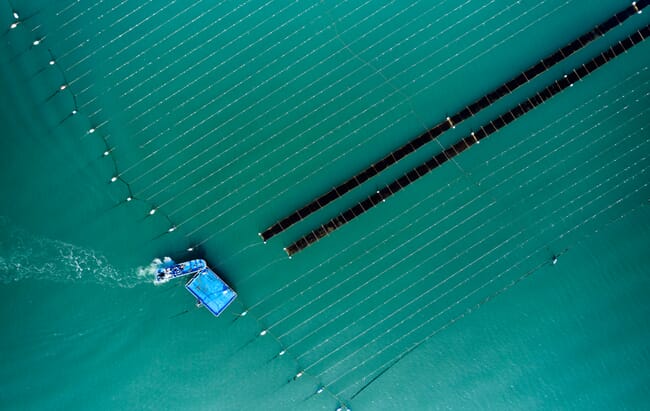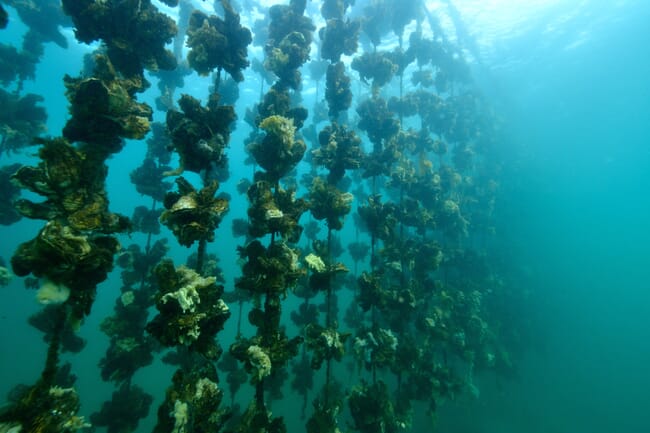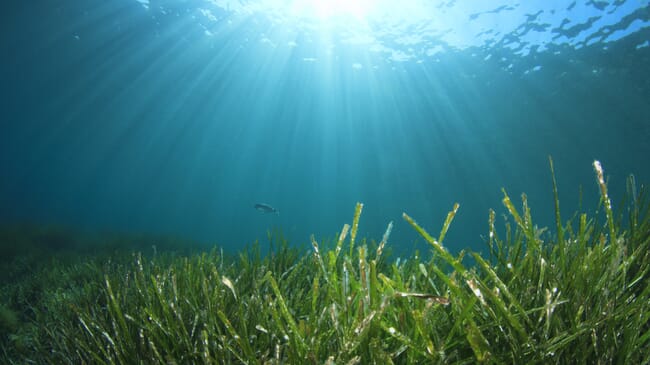
© Shutterstock
I get very uneasy when I hear blue carbon practitioners discuss growing macroalgae to sink into deep water as a carbon removal strategy. I can understand the reasoning: seaweed stores carbon in its blades instead of exporting it to the seabed. The plants themselves can decompose when left in their natural environment, releasing the sequestered carbon. Sinking seaweed to the ocean’s abyssal plain allows the carbon to be stored long-term, potentially giving us a new method to decarbonise the planet. But this method leaves many unanswered questions and may also come with serious drawbacks. If I’m being honest, I’m terrified of it.
I think it’s misguided to dump thousands of tonnes of farmed seaweed into a different ecosystem and assume it’s an environmental win. We need to take seabed conservation seriously. The adage is that we know more about outer space than we do about the deep ocean: at the moment, I don’t think we understand what we’d be dumping the seaweed onto.
The sea floor is a unique habitat and we’re only just starting to learn about it. Marine biologists in Ireland discovered a rare deep-water coral formation and reef a few years ago – I hardly think that type of discovery is an outlier. We haven’t done enough exploration to know what we’re throwing the seaweed on top of. We also don’t know what’s going to happen to the sunken biomass in 100 years, chemically or otherwise.
I think it’s fair to question the nutrient impact on the seabed that comes with dumping seaweed. Dumping anything in the deep ocean cannot be construed as being environmentally friendly or ethically conscionable when we have little or no understanding of the long-term effects of these actions.
The aquaculture sector relies on the environment for our livelihood. We have to be 100 percent sure of what we’re doing. Dumping seaweed is a bit like hiding it; and if it’s out of sight, it’s out of mind. Considering the potential benefits seaweed brings to the environment, sinking growth and “brushing it under the mat” is a missed opportunity.

Seaweed can ameliorate pollution, de-acidify the water and actively improve water quality, meaning farming seaweed yields huge benefits for shellfish producers and other forms of aquaculture. © Shutterstock
Another element of my unease about sinking seaweed relates to the claims the industry makes about sequestering carbon. Yes, the carbon capture potential is there; but if we’re being honest with ourselves, seaweed is much better at removing nutrients like nitrogen and phosphorous from the environment. Carbon removal is more of an ancillary benefit for the seaweed industry.
Macroalgae species are fantastic bio-mops – the plants can ameliorate pollution, de-acidify the water and actively improve water quality. Farming seaweed also yields huge benefits for shellfish producers and other forms of aquaculture. Seaweed is a means to an end, it isn’t a carbon panacea. The industry pitch should move beyond carbon capture and focus on removing other nutrients from the water.

With around 70 percent of Europe’s seagrass habitats having disappeared, restoring or increasing these areas would be more beneficial for carbon capture potential than sinking seaweed
If policymakers want to store carbon, they should maximise seagrass meadows instead of sinking seaweed. Around 70 percent of Europe’s seagrass habitats have disappeared. Restoring them or increasing the area seagrass and salt marsh habitats cover has enormous carbon capture potential. Improving carbon markets beyond their current hodge-podge would boost things as well.
Some macroalgae blue carbon pitches I’ve heard seem to be driven by a need to produce carbon credits and offsets that can be valorised – there’s little or no regard for the long-term consequences. Seaweed growers may get paid to dump biomass, but if the goal is to make money from carbon credits and improve the environment, we should focus on seagrasses and mangroves.
Cultivating seaweed for sinking stands out as an exceptionally poor use of resources. When I look at Europe’s seaweed sector, our biggest problem is lack of biomass. I have to ask why we’re talking about sinking our growth when the biotech, nutraceutical and ingredients sectors are crying out for high quality seaweed? Demand for this type of biomass is growing as well. The seaweed industry makes a lot of claims about circularity, minimising waste and identifying uses for every plant that we produce. This is largely undone if we dump it in deep water.
If we ever have to sink seaweed, we have failed. Even when I think of naturally occurring and problematic seaweed growth like Sargassum patches in the mid-Atlantic, I still think it’s better to collect it, clean it and use it for other purposes rather than sinking it to the sea floor.
Macroalgae can help us produce biodegradable plastics, pharmaceutical ingredients and protein. Our global population will likely reach 10 billion by 2050 – we need to feed people. Incentivising seaweed farmers to sink a source of high-quality protein doesn’t make any sense. And considering the industry’s other co-benefits, we can do better than leaving it on the sea floor.




